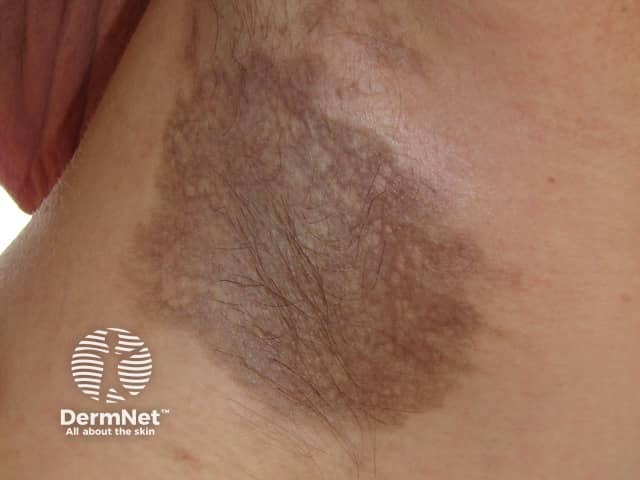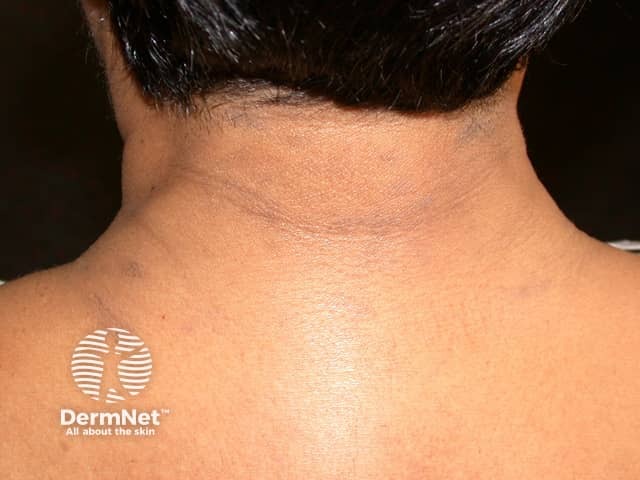Main menu
Common skin conditions

NEWS
Join DermNet PRO
Read more
Quick links
Erythema dyschromicum perstans — extra information
Erythema dyschromicum perstans
Author: Dr Monisha Gupta, Dermatologist, Sydney, Australia, 2009.
Introduction Demographics Causes Differential diagnoses Diagnosis Treatment
What is erythema dyschromicum perstans?
Erythema dyschromicum perstans is a form of acquired dermal macular hyperpigmentation characterised by well-circumscribed round to oval or irregular patches on the face, neck and trunk that are grey in colour. It is a form of acquired dermal macular hyperpigmentation. Erythema dyschromicum perstans is also called ashy dermatosis (of Ramirez), because of its colour.
- The pigmented patches may be symmetrical in distribution or unilateral.
- Early lesions may be reddish in colour, often with a more pronounced border, and they may be somewhat elevated. This phase is not always observed.
- The patient is otherwise well with no associated disease or blood test abnormality.

Erythema dyschromicum perstans

Erythema dyschromicum perstans

Erythema dyschromicum perstans
Who gets erythema dyschromicum perstans?
Erythema dyschromicum perstans most often affects darker-skinned patients, most frequently Latin Americans and Indians. It has also been reported in people of lighter skin colour and various ethnicities.
Erythema dyschromicum perstans may occur at any age but it appears to be more frequent in young adults. Women are affected more often than men.
What causes erythema dyschromicum perstans?
The exact cause for erythema dyschromicum perstans remains unidentified. It is often classified as a variant of lichen planus pigmentosus because of its histopathological features. Over the years, theories have included:
- Genetic susceptibility
- Contact allergy to cosmetics and hair dye
- Toxic effects of chemicals such as ammonium nitrate or barium sulphate
- Whipworm infestation
- Viral infections
- An adverse effect of drugs and medications.
What is the differential diagnosis of erythema dyschromicum perstans?
Several other skin conditions may appear similar to erythema dyschromicum perstans because they also result in discoloured skin patches.
- Acquired dermal macular hyperpigmentation
- Lichen planus pigmentosus
- Multiple lesions of fixed drug eruption
- Drug-induced skin pigmentation
- Postinflammatory hyperpigmentation
- Urticaria pigmentosa
- Incontinentia pigmenti
- Pinta
- Leprosy
How is erythema dyschromicum perstans diagnosed?
In some cases, the clinical picture of erythema dyschromicum perstans may be classical enough to diagnose the condition. A skin biopsy may reveal minor vacuolar degeneration of the basal layer in early lesions, and pigmentary incontinence with dermal melanophages in more established patches.
What is the treatment of erythema dyschromicum perstans?
Erythema dyschromicum perstans is rather resistant to currently available treatments. It may persist unchanged for years although some cases eventually clear up by themselves.
Treatments that may help improve the appearance of erythema dyschromicum perstans include:
- Topical steroids
- Exposure to ultraviolet radiation
- Pigment lasers, such as Q-switched ruby laser
- Chemical peels.
The most successful systemic treatment has been clofazimine. Dapsone, griseofulvin, hydroxychloroquine, isoniazid and corticosteroids have been used successfully in a few cases.
On DermNet
- Lichen planus
- Lichenoid disorders
- Acquired dermal macular hyperpigmentation
- Acquired dermal macular hyperpigmentation images
Other websites
- Erythema dyschromicum perstans — Medscape Drugs & Diseases
